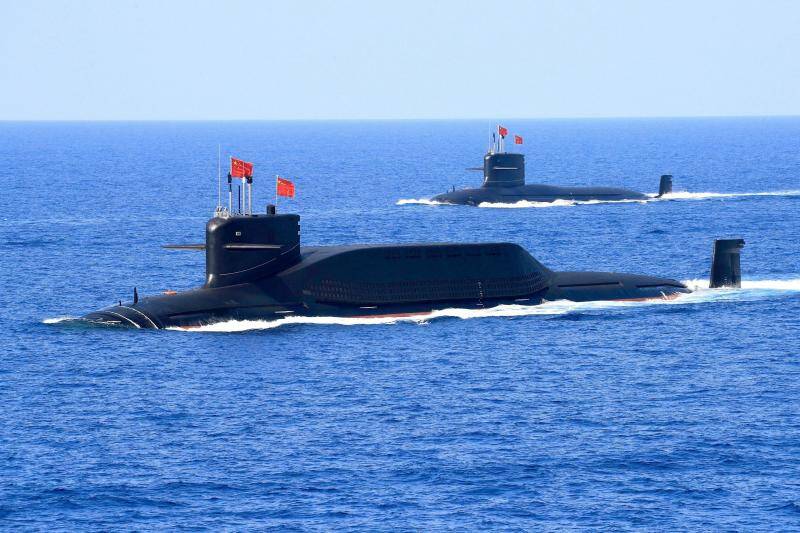A Taiwanese military expert on Wednesday rejected a China studies expert's claim that Beijing could impose a naval blockade on Taiwan by sending a few submarines into waters around the nation, questioning how long such a blockade could be sustained.
Based on impressions from two visits to Taiwan over the past three months, China studies expert Willy Lam (林和立) said at an Oct. 1 symposium in Washington that “all the Chinese need to do is send four or five submarines to impose a naval blockade of the island.”
Lam, a senior fellow at The Jamestown Foundation, speculated that if Chinese President Xi Jinping (習近平) orders “a big move on Taiwan,” the Chinese People’s Liberation Army (PLA) would impose an effective naval blockade “which they could do quite easily.”

Photo: Reuters
Speaking at a Taipei seminar held on Wednesday by National Chengchi University’s Institute of International Relations, Alexander Huang (黃介正) of Tamkang University said that strictly from a military perspective, the central question is how long a submarine blockade could be sustained if attempted.
“A nuclear-powered submarine might be able to stay in position for a long time, but crews still need to eat and sleep, so it cannot remain there indefinitely,” said Huang, an associate professor at the university’s Graduate Institute of International Affairs and Strategic Studies.
“With any blockade, the key question is how long you can sustain it, because it cannot last forever,” he said, in response to a question.
Another factor to consider is “whether those submarines can make it back,” Huang said, adding that other countries’ submarines might block their way to home ports in China.
If it comes to combat, those submarines may not make it back, Huang said, adding that Taiwan “is not without the means to hit back.”
A wargaming expert, Huang said that while Taiwan would be under great pressure in such a scenario, the longer a blockade lasts, the stronger the likelihood of international intervention becomes.
“If the US were to blockade the Strait of Malacca and bar Chinese ships from passing, Yangshan Port could also be struck,” he said, referring to the deep-water port off Shanghai that is an important hub for China’s import and export trade.
Lam’s remarks also drew reactions from Taiwanese officials at home and abroad.
After Lam delivered his remarks at the symposium, he was immediately countered by Representative to the US Alexander Yui (俞大㵢), who also attended the event hosted by the Global Taiwan Institute.
Disagreeing with Lam’s claim that a handful of submarines could blockade Taiwan, Yui said at the time the determination of the Taiwanese people to defend themselves is “pretty strong,” citing the tens of thousands who voluntarily went to Hualien County to assist with cleanup and recovery in areas hit by recent flooding.
Liang Wen-chieh (梁文傑), deputy head and spokesperson of the Mainland Affairs Council, also refuted Lam’s claim at a regular news briefing in Taipei.
“If it were that easy, all our years of force building and readiness would have been for nothing,” Liang said at yesterday's briefing.
“I therefore strongly disagree with his claim,” he added.

Taiwanese scientists have engineered plants that can capture about 50 percent more carbon dioxide and produce more than twice as many seeds as unmodified plants, a breakthrough they hope could one day help mitigate global warming and grow more food staples such as rice. If applied to major food crops, the new system could cut carbon emissions and raise yields “without additional equipment or labor costs,” Academia Sinica researcher and lead author the study Lu Kuan-jen (呂冠箴) said. Academia Sinica president James Liao (廖俊智) said that as humans emit 9.6 billion tonnes of carbon dioxide compared with the 220 billion tonnes absorbed

The Taipei Mass Rapid Transit (MRT) Wanda-Zhonghe Line is 81.7 percent complete, with public opening targeted for the end of 2027, New Taipei City Mayor Hou You-yi (侯友宜) said today. Surrounding roads are to be open to the public by the end of next year, Hou said during an inspection of construction progress. The 9.5km line, featuring nine underground stations and one depot, is expected to connect Chiang Kai-shek Memorial Hall Station to Chukuang Station in New Taipei City’s Jhonghe District (中和). All 18 tunnels for the line are complete, while the main structures of the stations and depot are mostly finished, he

Taipei is to implement widespread road closures around Taipei 101 on Friday to make way for large crowds during the Double Ten National Day celebration, the Taipei Department of Transportation said. A four-minute fireworks display is to be launched from the skyscraper, along with a performance by 500 drones flying in formation above the nearby Nanshan A21 site, starting at 10pm. Vehicle restrictions would occur in phases, they said. From 5pm to 9pm, inner lanes of Songshou Road between Taipei City Hall and Taipei 101 are to be closed, with only the outer lanes remaining open. Between 9pm and 9:40pm, the section is

China’s plan to deploy a new hypersonic ballistic missile at a Chinese People’s Liberation Army Rocket Force (PLARF) base near Taiwan likely targets US airbases and ships in the western Pacific, but it would also present new threats to Taiwan, defense experts said. The New York Times — citing a US Department of Defense report from last year on China’s military power — on Monday reported in an article titled “The missiles threatening Taiwan” that China has stockpiled 3,500 missiles, 1.5 times more than four years earlier. Although it is unclear how many of those missiles were targeting Taiwan, the newspaper reported